ISSN ONLINE(2319-8753)PRINT(2347-6710)
ISSN ONLINE(2319-8753)PRINT(2347-6710)
Mr. G. T. Sutar1 and Prof. Mr. A.V. Shah2
|
| Related article at Pubmed, Scholar Google |
Visit for more related articles at International Journal of Innovative Research in Science, Engineering and Technology
The NPR (Number Plate Recognition) using is a system designed to help in recognition of number plates of vehicles. This system is designed for the purpose of the security system. This system is based on the image processing system. This system helps in the functions like detection of the number plates of the vehicles, processing them and using processed data for further processes like storing, allowing vehicle to pass or to reject vehicle. NPR is an image processing technology which uses number (license) plate to identify the vehicle. The objective is to design an efficient automatic authorized vehicle identification system by using the vehicle number plate. The system is implemented on the entrance for security control of a highly restricted area like military zones or area around top government offices e.g. Parliament, Supreme Court etc. The developed system first captures the vehicle image. Vehicle number plate region is extracted using the image segmentation in an image. Optical character recognition technique is used for the character recognition. The resulting data is then used to compare with the records on a database. The system is implemented and simulated in Matlab, and it performance is tested on real image. It is observed from the experiment that the developed system successfully detects and recognize the vehicle number plate on real images.
Keywords |
| Number Plate Recognition, vehicle identification, optical character recognition, Gray Processing, Image Acquisition, Image Binarization, and Vehicle number plate, Number Plate Extraction, Character Segmentation, Template Matching. |
INTRODUCTION |
| Massive integration of information technologies into all aspects of modern life caused demand for processing vehicles as conceptual resources in information systems. Because a standalone information system without any data has no sense, there was also a need to transform information about vehicles between the reality and information systems. This can be achieved by a human agent, or by special intelligent equipment which is be able to recognize vehicles by their number plates in a real environment and reflect it into conceptual resources. Because of this, various recognition techniques have been developed and number plate recognition systems are today used in various traffic and security applications, such as parking, access and border control, or tracking of stolen cars. |
| In entrance gate, number plates are used to identify the vehicles. When a vehicle enters an input gate, number plate is automatically recognized and stored in database and black-listed number is not given permission. When a vehicle later exits the place through the gate, number plate is recognized again and paired with the first-one stored in the database and it is taken a count. Automatic number plate recognition systems can be used in access control. For example, this technology is used in many companies to grant access only to vehicles of authorized personnel. |
SYSTEM MODEL |
| The overall ANPR system can be subdivided into the software model and hardware model. The section will discuss the both models in detail. |
a) Software Model |
| The main and the most important portion of this system is the software model. The software model use series of image processing techniques which are implemented in MATLAB. The NPR algorithm is broadly divided into following parts: |
| • Capture image. |
| • Pre-processing. |
| • Plate region extraction. |
| • Segmentation of character in the extracted number plate. |
| • Character recognition. |
| • Comparison with database. |
| • Indicate result. |
| The flow chart of license plate recognition system implementation in this work is shown in the following figure. There are various steps in this approach and these are implementation in MATLAB. |
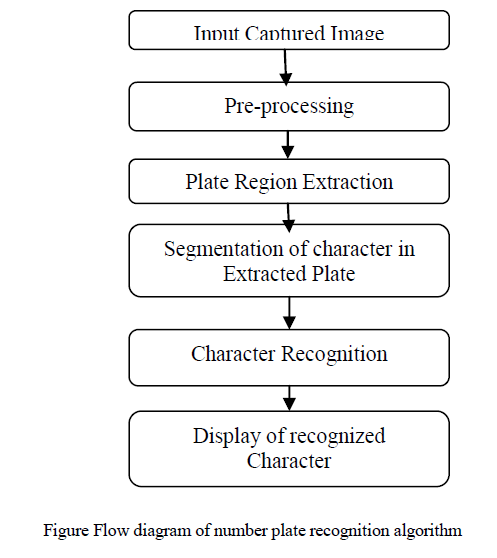 |
IMPLEMENTATION WORK |
1) Capture image(Image acquisition) |
| The first step is the capturing of an image using electronic devices such as optical (digital/video) camera; webcam etc can be used to capture the acquired images. For this project, vehicle images will be taken with a Panasonic FX/Nikon digital camera. In this project pre-captured image will taken. The images will be stored as colour JPEG format on the camera. Next, we might proceed in using the Matlab function to convert the vehicle JPEG image into gray scale format Input of this system is the image captured by a camera placed at a distance of 1-2 metres away from the vehicle as shown in following Fig. |
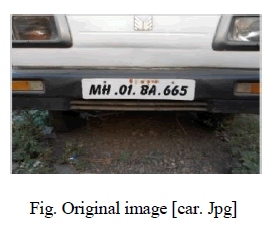 |
2) Pre-processing. |
| After the acquisition of image, pre-processing of image is done. When an image is acquired, there may be noises present in an image. These noises affect the recognition rate greatly. So these noises should be removed from the images. |
Gray Processing: |
| It involves conversion of color image into a gray image. The method is based on different color transform. According to the R, G, B value in the image, it calculates the value of gray value, and obtains the gray image at the same time. |
Median Filtering: |
| When images are acquired there is lot of noises present in image. The noise cannot be eliminated in gray processing. To remove noise from the image median filters are used so that image becomes free from noise. Noise removal is necessary step in License plate recognition system because it greatly affects the recognition rate of the system. Gray scale image is shown in following fig. |
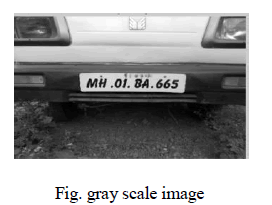 |
3) Method 1: Plate region extraction. |
| The third step of the ANPR algorithm is the extraction of the number plate in an image. find the row and column value of that image, then modify the image by using r/3:r. and save the image in another variable, assign the location and display the image, find the row and column for modified image, create one dummy image in the size of modified image row and column, and find the each and every pixel value if the pixel value is greater than 150 means put the value 1 in dummy image else put 0 in dummy image, then apply median filter for that image. Find the region props of the image means it will calculate the centroid, boundary and etc then we have some condition based on that condition we apply the further procedure .following fig. shows the extracted number plate. |
| Equations |
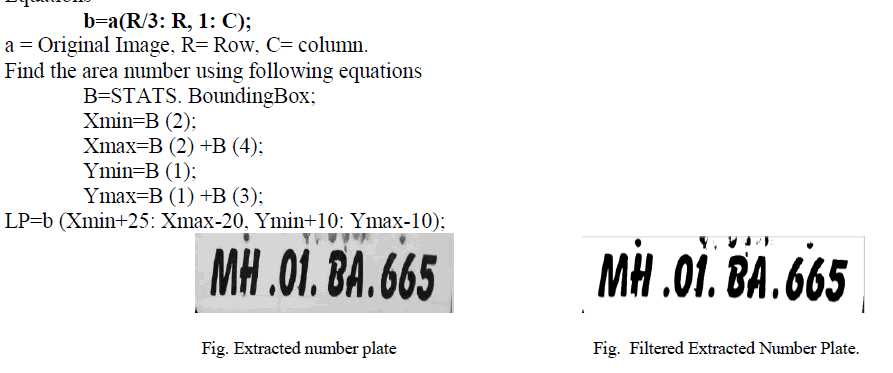 |
Method 2: |
| Number plate extraction is the key step in ANPR system, which influences the accuracy of the system significantly. The goal of this phase, given an input image, is to produce a number of candidate regions, with high probability of containing number plate and validate for true number plate. In this step extract vehicle number plate from eroded image. Following fig. show the algorithm of plate region extraction. Plate region extraction algorithm following figure shows the input image. |
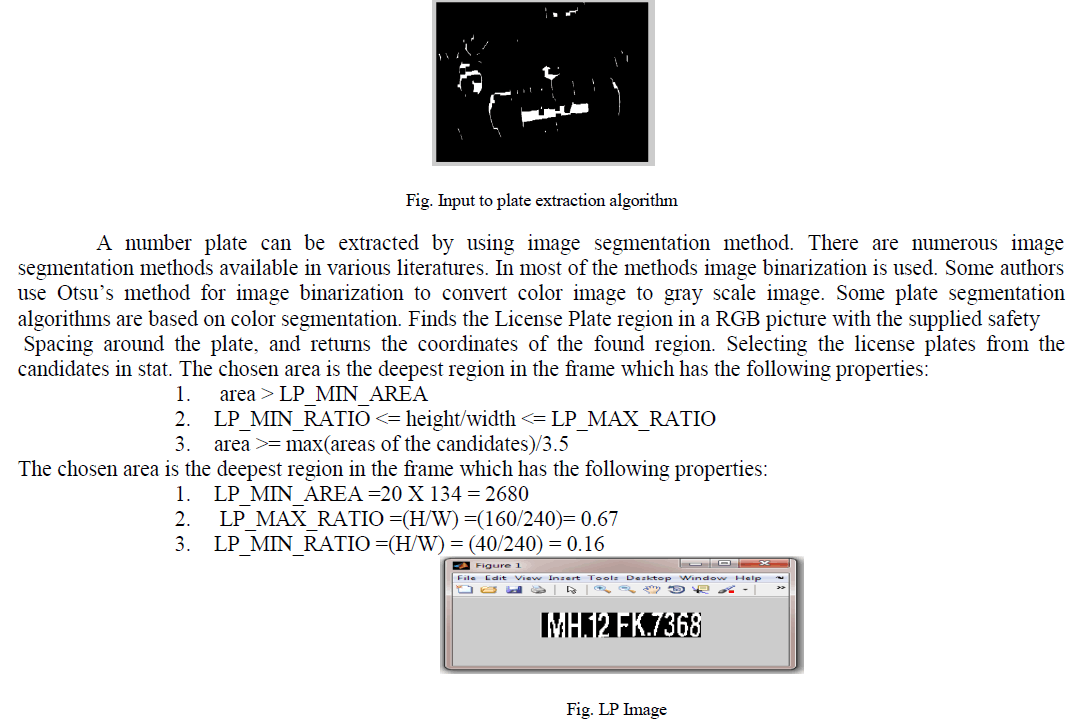 |
Skew Correction and Detection: |
| The process of identifying lines in an image is then quite simple, apply RADON transform to image with line extract the bright peaks using some threshold and then extract line parameters from position of the peaks. |
| Following steps are used for skew detection and correction: |
| 1. Read grayscale image |
| 2. Binaries this image. |
| 3. Apply RADON transform to the image. |
| 4. Find maximum radon transform matrix or peaks or line. |
| 5. Find angle which corresponds to the maximum. |
| 6. Plate line skew angle =90-skew angle. |
| 7. Rotate original image by angle in step 6. |
| Following figure shows the algorithm for Skew Correction and Detection. |
 |
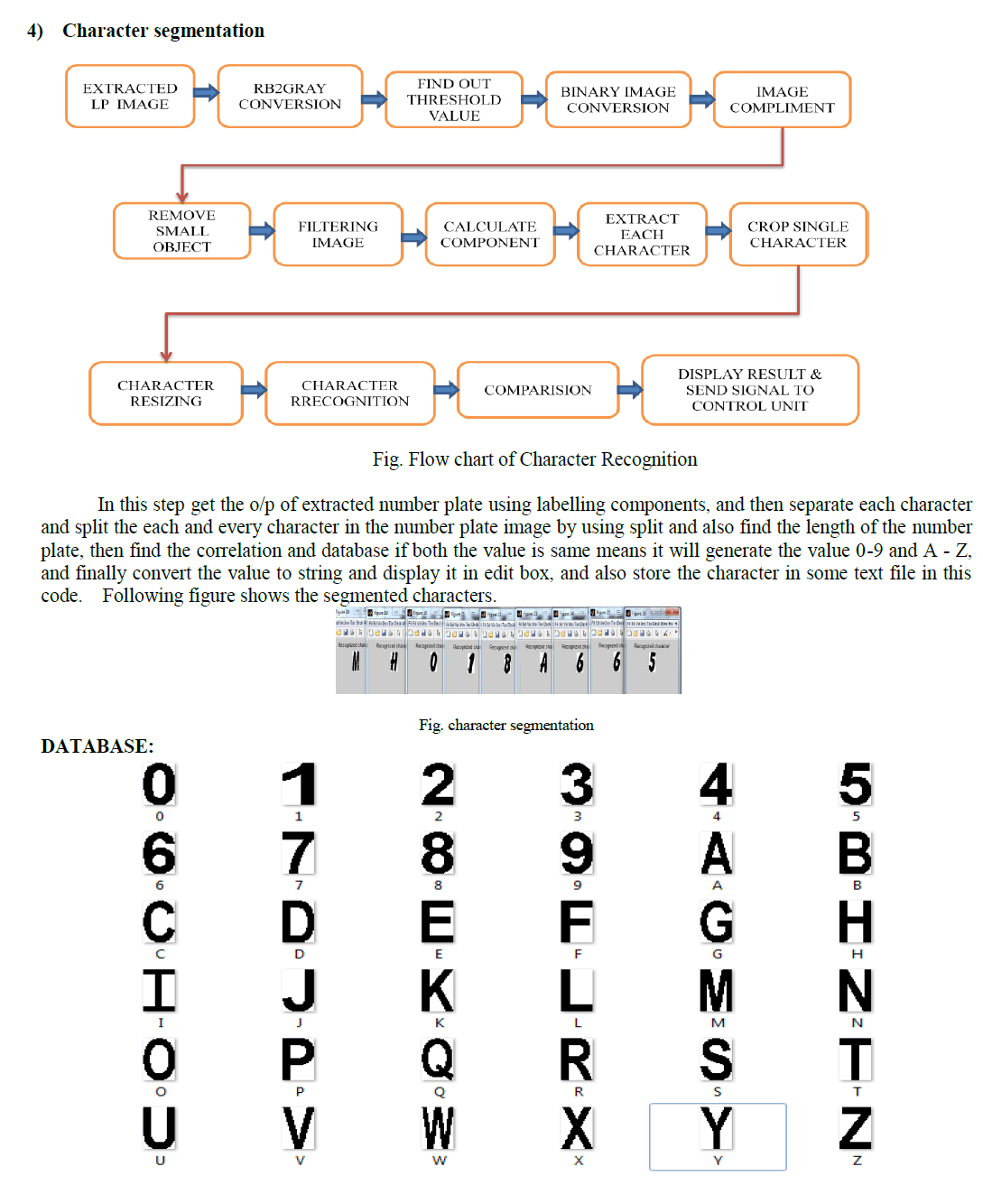 |
5) Character recognition. |
| The OCR is now used to compare the each individual character against the complete alphanumeric database. The OCR actually uses correlation method to match individual character and finally the number is identified and stored in string format in a variable. The string is then compared with the stored database for the vehicle authorization then recognized number plate string is compare with authenticated database file, , if the both value is same means it will display the authorized otherwise it will display the unauthorized |
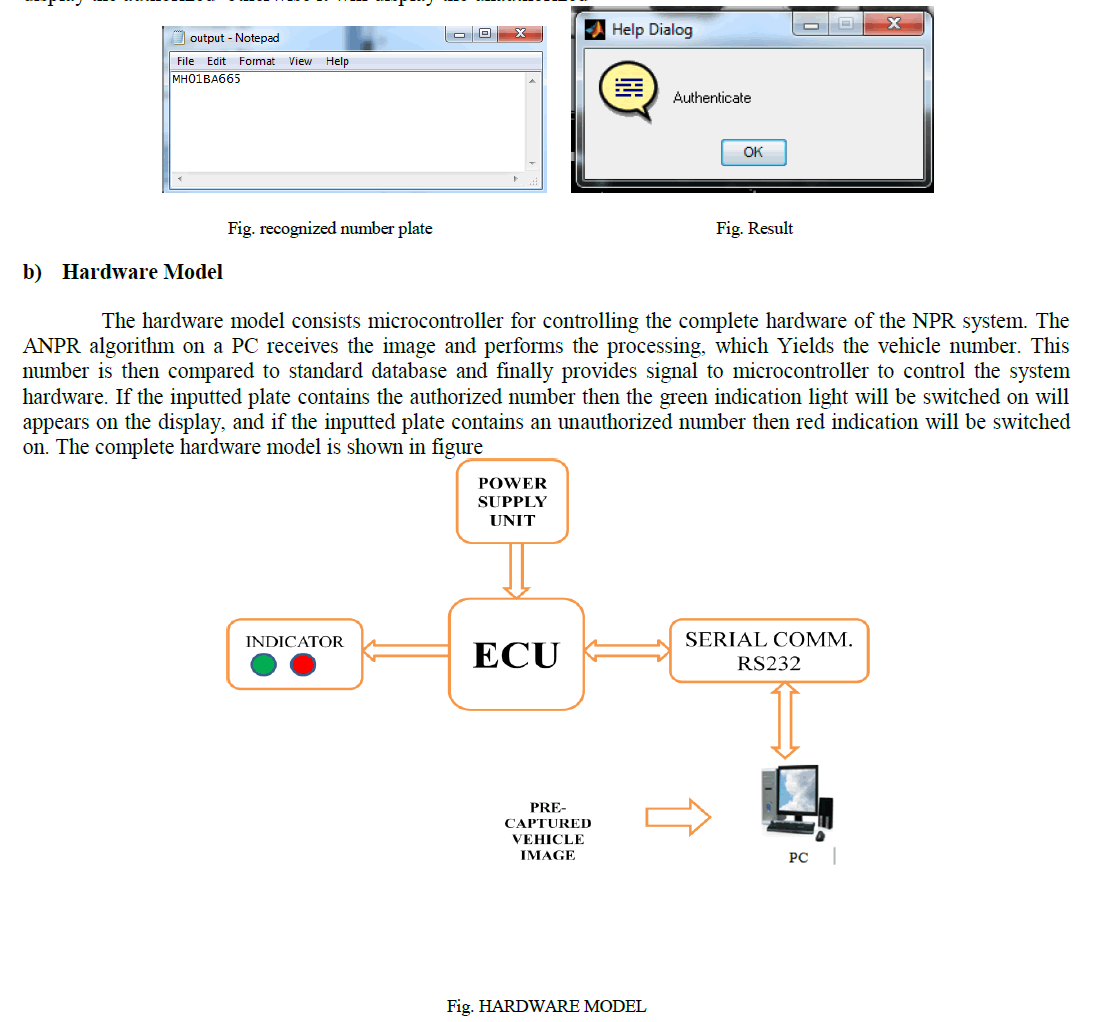 |
EXPERIMENTAL RESULTS |
| This section presents the simulation results of the developed VNPR system. Different images of cars having different colours and structure types are taken and stored in PC. The images are in RGB format and the resolution is 1536X2048 or 640X480 pixels as shown in fig (a). |
| EXAMPLE-1 |
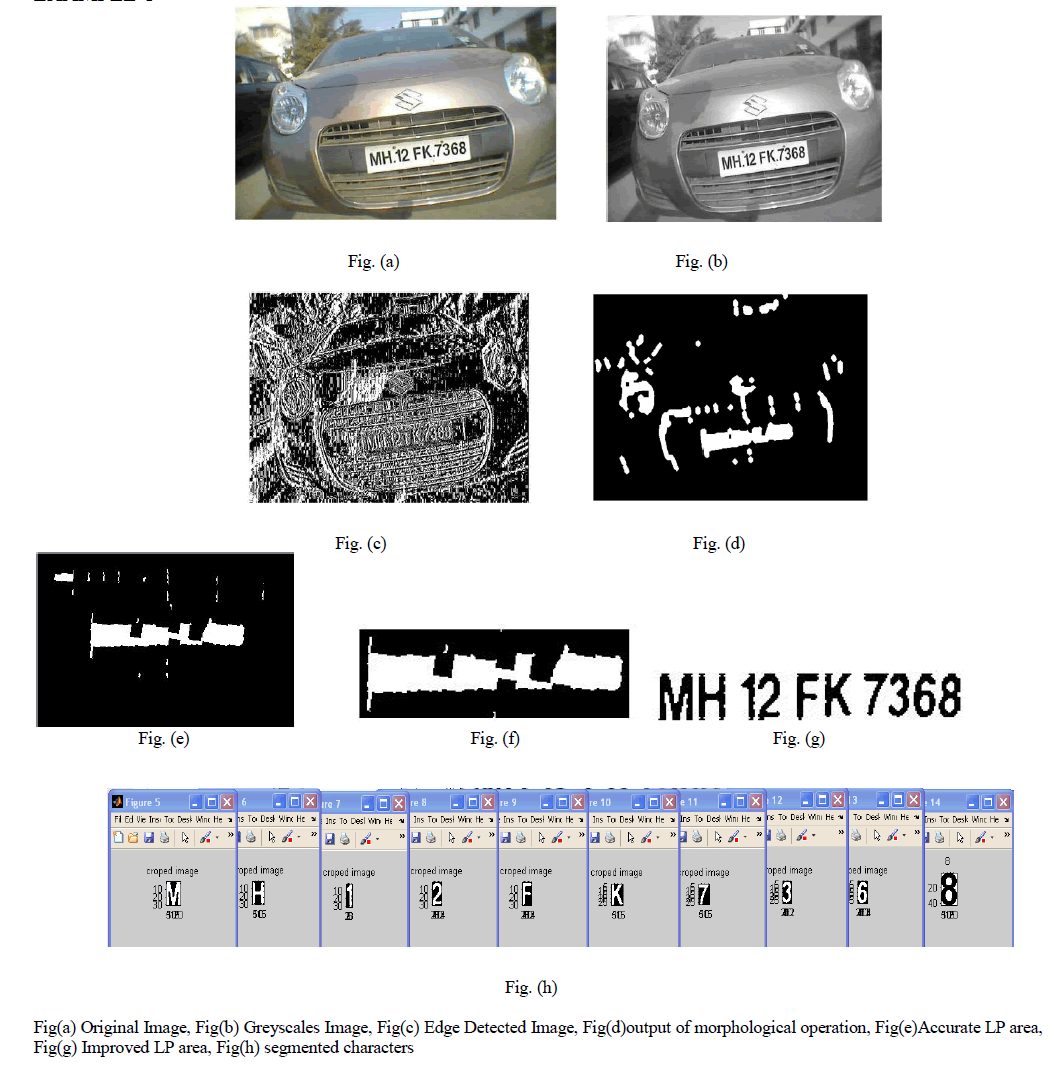 |
CONCLUSION |
| We have implemented number plate recognition. Our algorithm successfully detects the number plate region from the image which consists of vehicle number & then character segmentation, recognition .We have applied our algorithm on many images and found that it successfully recognition. |
| The project was designed keeping in mind the automation of the number plate detection system for security reason that could replace the current system of manual entry. This project was a success in recording the number plate of a vehicle although it has got its own limitation of image processing and other hardware requirements. From this project we learn about image processing and OCR (Optical Character Reader), hardware interface in this paper, the automatic vehicle identification system using vehicle license plate is presented. The system use series of image processing techniques for identifying the vehicle from the database stored in the PC. The system is implemented in Matlab and it performance is tested on real images. The simulation results shows that the system robustly detect and recognize the vehicle using license plate against different lightening conditions and can be implemented on the entrance of a highly restricted areas. |
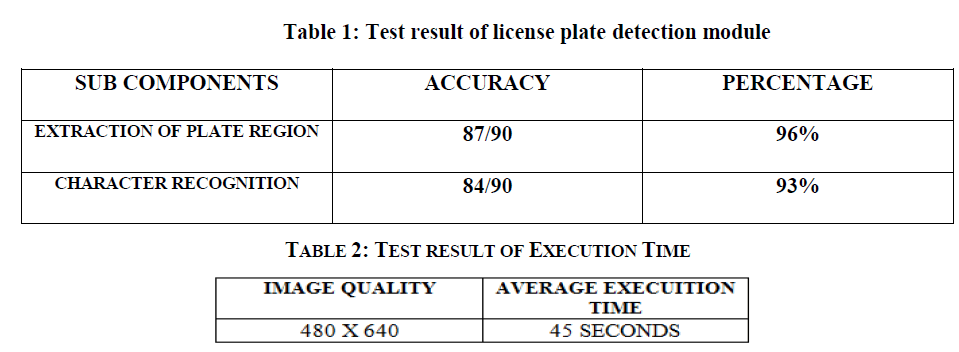 |
References |
|